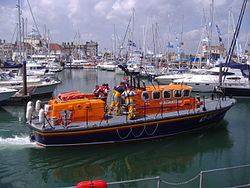Official Number ON 1132 Cost £2.5 million Tonnage 31,500 kg | Christened 1987 Draft 1.35 m | |
 | ||
Sponsored by The Lowestoft Appeal with other gifts and legacies | ||
RNLB Spirit of Lowestoft (ON 1132) is a Tyne-class lifeboat which was stationed at Lowestoft in the English county of Suffolk The lifeboat commenced its service at the station in 1987 and was replaced by a Shannon class boat in 2014.
Contents
Design and construction
Like all the Tyne Class Lifeboats, the Spirit of Lowestoft was designed as a fast slipway boat (FSB) and featured a semi-planing hull fabricated from steel. This hull had a shallow draught and a long straight keel with a flared bow above the waterline. To protect the propellers they were housed in tunnels with substantial bilge keels, and a straight wide keel ending at a hauling shoe enabling winching for the boat when it was returned up the slipway, or to operate in shallow waters where hitting the bottom was a concern as is the case at Lowestoft.
Equipment
The lifeboats power came from twin General motors GM6V92TA DDEC turbo-charged marine two-stroke diesel engines which could develop 525 brake horsepower (391 kW). These engines could push the lifeboat to a top speed of 18 knots (33 km/h). At full speed there was enough diesel fuel in the tanks for ten hours service. At lower speeds the endurance was significantly increased. The engines were computer-managed, with data being displayed on twin screens which was viewed at both the Mechanic’s and the Helm position in the wheelhouse. Within the wheelhouse there were six seats for the crew plus a jumper seat for a doctor. Spirit of Lowestoft’s equipment included satellite navigation apparatus interfaced through a PC to a visual chart display. Daylight viewing radar was used both for navigation and to search for casualties. There was VHF radio direction-finding equipment for locating vessels in trouble. The lifeboat also carried the latest DSC digital radio equipment for the vital radio communication used in search and rescue missions. The lifeboat was equipped with three VHF radios, one of which was portable, together with an MF `long range`set. On the deck were powerful searchlights, and the lifeboat was also later equipped with image-intensifying night sight equipment. Spirit of Lowestoft carried a large amount of first-aid equipment including both oxygen and entonox.
29 August 1996
During storm force winds the Spirit of Lowestoft was launched, along with the Aldeburgh Lifeboat Freddie Cooper (ON 1193) to go to the assistance of the yacht Red House Lugger which had sent out a call of Mayday and was approximately 30 miles (48 km) south east of Lowestoft. The yacht was on passage from the Netherlands with her skipper, a schoolmaster, and four passengers who were four teenage school children. Both lifeboats reached the stricken yacht at 10:15 am and found that the P&O cargo ferry called Norking was standing by and was providing some shelter for the yacht. The Freddie Cooper managed to get alongside and pulled three of people of the yacht. The second coxswain of the Spirit of Lowestoft, Shane Coleman was then put aboard the yacht and helped the remaining people on to the Lowestoft boat. The yacht was then towed to Harwich to complete what had been a long and arduous shout. The Lowestoft lifeboat finally got back to it birth at 11:30pm. On the 27 November 1996, coxswain of the Spirit of Lowestoft, John Cathpole and coxswain of the Freddie Cooper, Ian Firman, both received RNLI bronze medals for their part in this rescue. Second coxswain Shane Coleman was awarded the Thanks of the Institution on Vellum.
